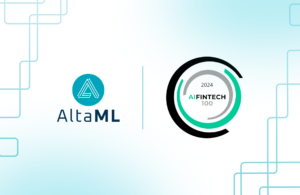Implementing AI Solutions: Advancing Use Cases Beyond Proof of Concept
November 16, 2023
•
4 min read
Operationalizing solutions is a major challenge, especially when automation needs to be scaled across multiple parts of the organization. According to a McKinsey & Company global survey, only 36% of artificial intelligence (AI) solutions had been deployed beyond the pilot stage.
At AltaML, roughly 70% of the AI solutions that have passed feasibility are moving towards operationalization. So, how come our models have an almost twofold likelihood of reaching production?
The fundamental stages involved in successfully implementing use cases are outlined below.
Develop Business Understanding
Among the initial challenges that must be addressed before AI projects advance to the deployment stage is ensuring leaders have a comprehensive grasp of their practical value. Developing an understanding of AI isn’t an easy road especially merging the technical and business aspects together. It can be hard for leaders to translate the so-called AI “black box” into practical applications, which makes it harder for them to steer their teams through AI adoption.
Some organizations choose to start by focusing on a single organizational unit first, whereas others tackle multiple units from the start. Either approach can work, and there are numerous examples to support this. Regardless of the approach chosen, the real challenge arises when there’s a lack of initial consideration about how AI will fit into the broader business workflow and enhance the end-user experience. One important early question to pose to clients is, “Imagine we build a model that achieves nirvana, and it’s 100% accurate, would you use it?” Surprisingly, sometimes the answer is “no.” Without addressing this question upfront and giving it serious consideration, work on development may have already started and continue to progress, potentially leading to wasted efforts down the line.
Be Relentless about Feasibility
The main reason why AI projects fail is, in a sense, the same reason why any project fails: there is a lack of consideration upfront if the proposed hypothetical solution is feasible. A rigorous feasibility study is the key to determining the chances of the modeling effort ultimately succeeding or not. Here are a few points you might want to cover during a feasibility study to assess how likely it is that your model will add value to your business.
Availability and Quality of Data
No AI can be trained without sufficient data; however, making sure the data you will use is qualitatively and quantitatively adequate can pose a significant obstacle. Do you already have a reliable source of in-house data on tap? If you don’t, how are you going to acquire it, i.e., web scraping, third-party vendors, clients/partners, synthetic data? How much will it cost you? Are there any privacy or ethical concerns to consider? What about data usage rights? Can you harness data with intent while remaining compliant with legal requirements? These are crucial questions that require in-depth exploration and clear answers.
Estimate Your Levels of Effort
How hard is it going to be to reach the various milestones required to complete your AI project? Estimating your levels of effort for each milestone is a very important step for assessing the time and resources required to establish a safe production path on the road to completion.
Sometimes, in discussions with clients, we encounter situations where the return seems disproportionate to the problem’s size—it’s akin to investing $1 million to solve a $100,000 problem. By carefully estimating the benefits, you can prevent imbalances and ensure that your resources are allocated efficiently throughout the project life cycle. Of course, there are use cases in which the benefits are strategic in nature and in those cases the investment may very well be warranted.
Evaluate Your Team Beforehand
To develop a model, you need a team with the right skills and competencies. This means defining who’s who before the project starts, and if it’s actually possible to leverage only internal resources or if you need to hire new talent. If you do need to hire new talent, how much will that cost? Can they be integrated into your current talent mix and organizational design with minimal effort? Are you going to partner with another company to leverage their experience? Addressing these questions prior to initiating your project can spare you from substantial headaches down the road.
Should Every Proof of Concept Succeed?
Even after a successful feasibility study, many proof-of-concepts (PoCs) fall short of progressing to the production stage. This outcome isn’t necessarily anyone’s fault; it predominantly stems from the nature of the PoC being based on the simplest possible version of the model, trained on relatively limited data, and designed to address a single, typically specialized use case. However, ensuring the model’s seamless integration into the company’s infrastructure, its performance under real-world circumstances, and its ability to deliver value and efficiency presents an entirely separate challenge.
So, how can you ensure that projects don’t fail once they reach the PoC stage? The truth is, during PoC you are still in a learning phase, some PoCs are bound to fail—it’s an inherent part of their purpose. What you can control is the amount of time and resources you invest. Don’t hesitate to halt a project in its early stages. Each time you do, your organization gains valuable insights into its needs and the most effective ways to meet them.
Conclusion
To increase the rate of operationalization, it is critical to adopt human-centered, agile thinking. It’s important to have gates, to iterate, learn fast and not be married to an idea for too long, if you have any indication that it’s not the best investment of your time and effort. While only a handful of projects exhibit immediate results, over time, and through consistent development while adhering to the aforementioned best practices, you can effectively operationalize more of your AI use cases and even more importantly, increase their rate of adoption by business users.
 Navigating Bias in AI with Open-Source Toolkits
Navigating Bias in AI with Open-Source Toolkits
 AltaML Secures Spot on AIFinTech100 for Consecutive Year
AltaML Secures Spot on AIFinTech100 for Consecutive Year
 Jurisage and CiteRight Finalize Merger, Become Jurisage Group Inc.
Jurisage and CiteRight Finalize Merger, Become Jurisage Group Inc.


